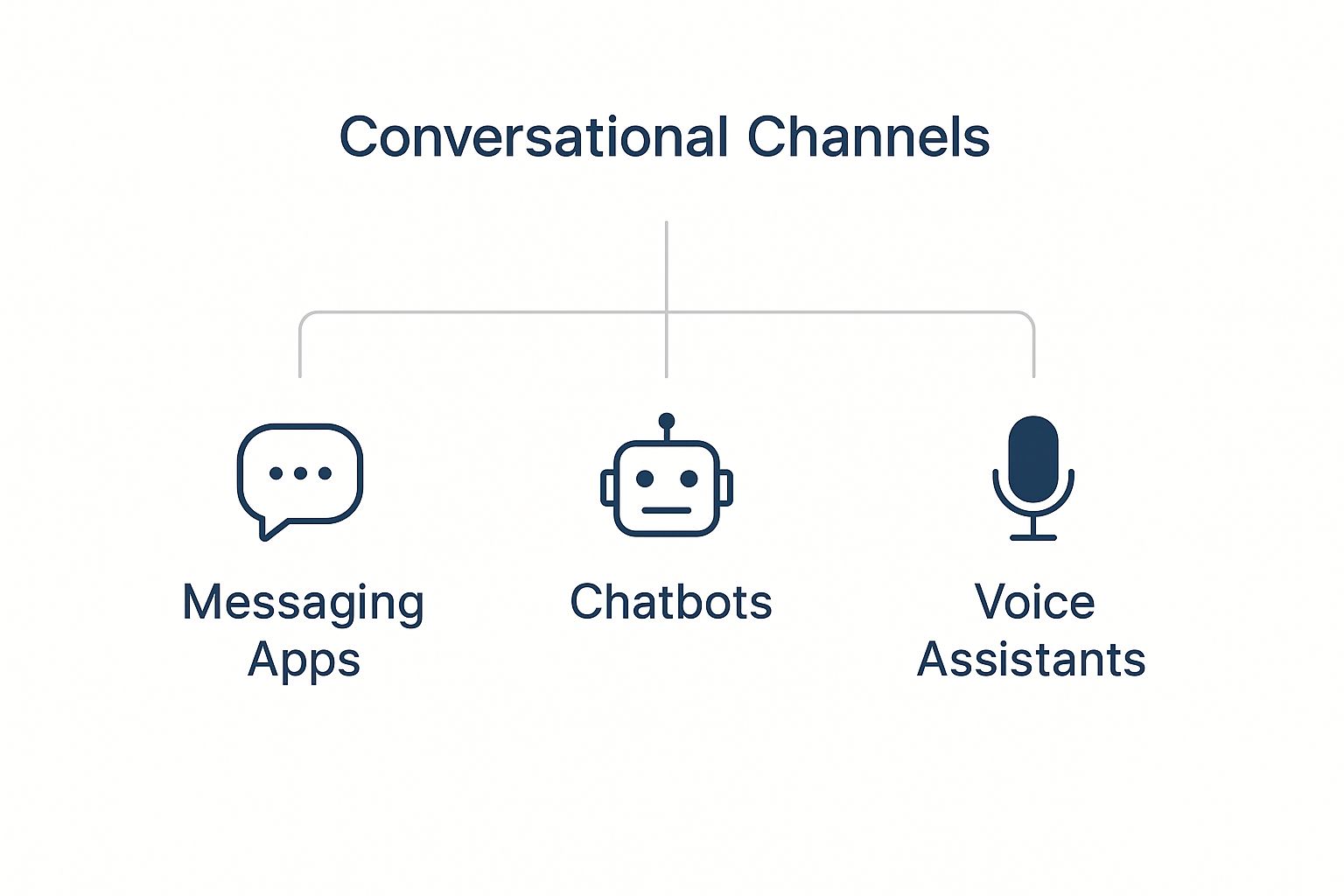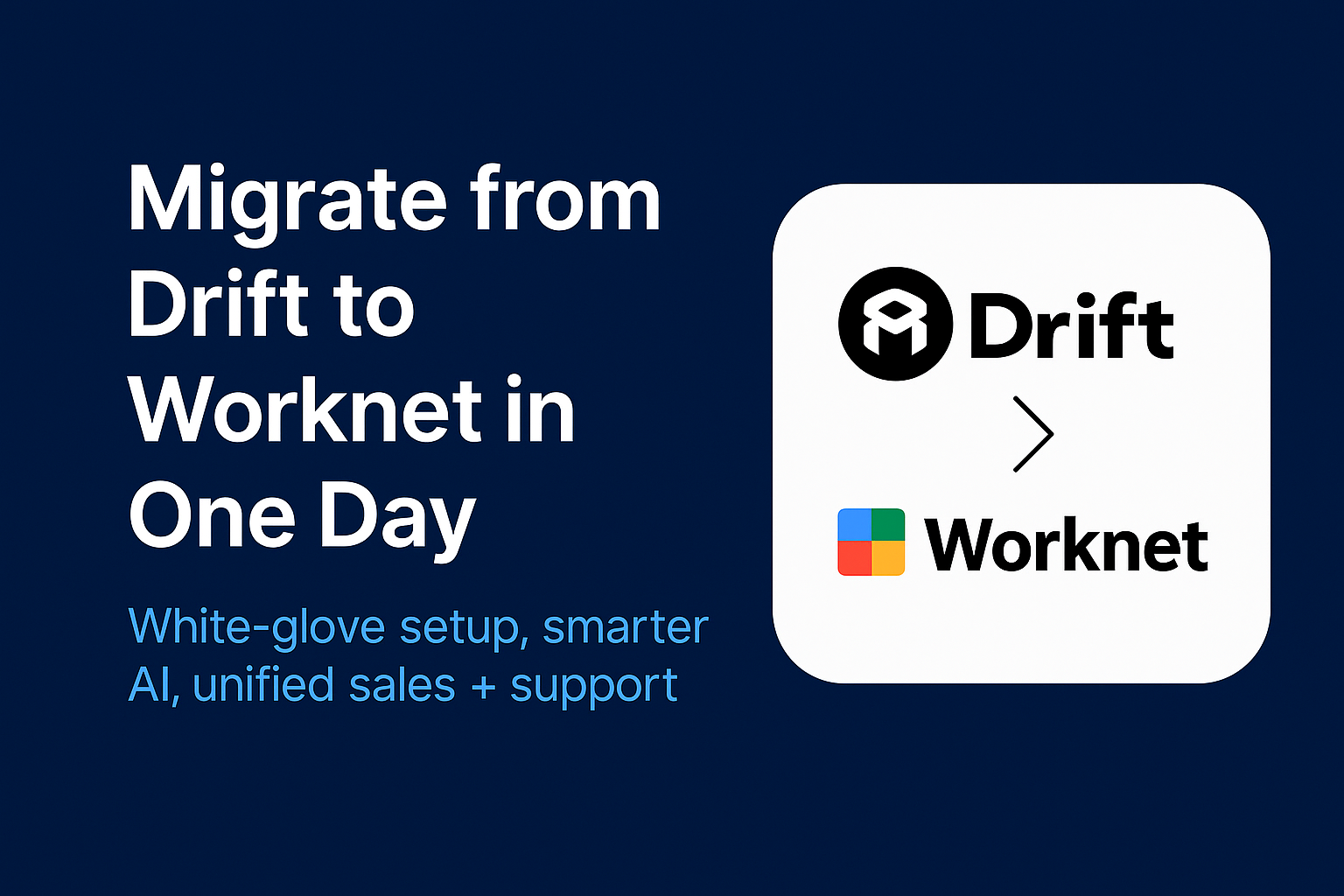Master Conversational Customer Service for Better Support
Remember that feeling you get at a great local coffee shop? The barista knows your name, remembers your usual order, and asks how your week is going. That personal, effortless connection is exactly what conversational customer service brings to the digital world.
It’s all about moving away from rigid, forgetful support tickets and toward fluid, ongoing conversations that build real, lasting relationships. This guide will walk you through exactly what it is, why it's a game-changer, and how you can implement it step-by-step.
What Is Conversational Customer Service?

At its core, conversational customer service treats every customer interaction as part of one long, continuous dialogue. It's a simple but powerful idea: stop making customers repeat themselves every single time they contact you.
This approach uses technology to weave together a customer's entire history—every web chat, email, social media message, and phone call—into a single, unified view. Instead of a pile of disconnected support tickets, you get one cohesive "customer story." This gives both your automated bots and human agents the full context they need to offer help that’s not just fast, but genuinely personal and smart.
From Transactional Tickets to Meaningful Relationships
Let’s be honest, the old way of handling support is broken. It was purely transactional. A customer has an issue, you create a ticket. You solve it (hopefully), close the ticket, and the interaction is filed away, rarely to be seen again. When the next problem pops up, the customer is forced to start from square one, which is a recipe for frustration.
Conversational service completely flips that script. It’s built for relationships, not just transactions. By using AI and unified communication tools, it creates a persistent, intelligent conversation. A customer might start with a chatbot on your site, send a follow-up email the next day, and then hop on a call. In a true conversational model, that agent sees the entire journey instantly. No more "Can you give me your ticket number?" or "Can you explain the problem again?" It’s just a seamless, helpful experience.
Key Takeaway: The whole point is to make talking to your business feel like a natural conversation with someone who actually remembers you. This builds incredible trust and shows customers they're truly valued.
To really see the difference, let’s compare the two approaches side-by-side.
Traditional Support vs Conversational Customer Service
This table highlights a fundamental shift in mindset. It’s about moving from a reactive cost center to a proactive relationship-builder.
This isn't just a fleeting trend; it's a direct response to how customer expectations have changed. We live in an age of instant messaging and AI assistants, and people now expect the same from the businesses they support. In fact, around 73% of consumers believe AI can improve their customer experience, which shows just how comfortable people are with this new reality. If you want to dive deeper, you can discover more insights about AI in customer service and see just how much perceptions have evolved.
By embracing this conversational approach, you’re not just solving problems—you’re turning your support function into a powerful engine for customer loyalty and business growth.
Why Conversational Service Is a Game Changer

Moving to a conversational approach does a lot more than just put a smile on your customers' faces. It’s a fundamental shift that directly impacts your bottom line, creating real, tangible results that set you apart from the competition.
When you treat customers like people, not tickets, you start building real relationships. It’s that simple. These personal, context-aware interactions build a deep sense of trust that can turn a one-off buyer into a loyal fan for life, which is a game-changer for customer lifetime value.
Boosting Loyalty and Reducing Costs
The real magic of conversational customer service lies in its one-two punch: it creates fantastic, memorable experiences that build loyalty while also making your entire operation more efficient.
Think of smart automation as your first line of defense. It’s always on, ready to handle the flood of routine questions—like "Where's my order?" or "How do I reset my password?"—instantly, 24/7. This gives customers the immediate answers they want and takes a huge weight off your human support team.
With automation handling the basics, your human experts are freed up to do what they do best: tackle the tricky, high-value problems that need a human touch. Instead of getting bogged down by repetitive questions, they can focus their energy on building relationships and saving customers who might be about to churn. This leads to a more fulfilled team and a much smarter use of your resources.
It's clear this is where the industry is heading, with projections showing AI will soon be behind 95% of all customer interactions. And yet, poor service costs U.S. companies a staggering $75 billion every year. Conversational tools are tailor-made to bridge that gap. You can read more about these critical customer service statistics to grasp the full financial picture.
Making the Business Case for Investment
Let's be clear: investing in a conversational strategy isn't a "nice-to-have" anymore. For any business that wants to grow sustainably, it's essential. The business case is straightforward and powerful.
It creates a virtuous cycle that benefits your entire operation:
- Reduced Operational Costs: By automating a huge chunk of your inbound questions, you lower the cost of each interaction and don't need to hire as many people to handle the volume.
- Increased Agent Productivity: When agents aren't tied up with boring, repetitive tasks, they can handle more complex issues each day. This boosts team efficiency and makes their jobs more rewarding.
- Higher Customer Retention: Customers who feel heard and understood stick around. These ongoing, personal conversations dramatically improve loyalty and keep churn rates down.
When you connect the dots, the initial investment quickly pays for itself through a combination of saved costs and new revenue. To see how this all comes together, our guide on using conversational AI for customer service breaks down these principles in action. It's how you turn customer support from a cost center into a true engine for growth.
Building Your Conversational Toolkit
A truly great conversational experience doesn't come from a single piece of tech. It’s built from a connected ecosystem where every part works in harmony. To create effective conversational customer service, you need to assemble the right toolkit. Think of it like building a high-performance engine—each part has a specific job, but they all need to work in perfect sync to deliver real power and reliability.
The absolute foundation of this toolkit is an omnichannel platform. This is the central nervous system of your entire support operation. It brings every channel together—live chat, social media messages, email, even phone calls—into one seamless, continuous conversation. This means no more lost context or fragmented histories just because a customer moves from your website to their phone.
The Brains and the Memory
Once you have that nervous system, you need the brains of the operation: AI and machine learning. This is what gives chatbots and virtual assistants the ability to go beyond rigid, pre-written scripts. Modern AI can actually understand what a customer wants, their sentiment, and the subtleties of human language. This allows them to give instant, accurate answers to common questions, 24/7.
A key part of many modern conversational strategies involves utilizing WhatsApp chatbots. This approach meets customers on a platform they’re already comfortable using every day, making support feel less like a formal ticket and more like a quick text to a friend.
But having the tech is only half the battle. Despite all the promise, only about 25% of call centers have actually integrated AI into their day-to-day operations. This highlights a huge gap between owning the tools and knowing how to use them effectively.
Unifying the Customer Story
The final, and arguably most critical, piece that ties everything together is the unified customer profile. Think of this as the system's long-term memory. It's a living, 360-degree view of every customer, pulling together their interaction history, purchase data, and preferences into one single, accessible record.
This shared context is what makes truly personal interactions possible. When a human agent—or even a bot—can see a customer's entire journey, the support they provide is relevant and proactive, not repetitive and generic.
This diagram illustrates how these different channels flow into a unified strategy.

As you can see, modern support needs to seamlessly integrate messaging, chatbots, and voice to meet today's customer expectations. When you combine these three components—the omnichannel platform, intelligent AI, and the unified profile—you create a system that is far more powerful than the sum of its parts.
Your Step-by-Step Implementation Plan

Jumping into conversational customer service can feel like a massive project, but it really doesn't have to be. The secret is to take it one step at a time. A phased approach is your best friend here—it minimizes risk and lets you score some quick wins to get your team excited and on board.
A "crawl, walk, run" strategy is the most effective method. You start small, prove the concept works, and then build on that success. This practical roadmap will walk you through the process, setting you up for a smooth and successful rollout.
The journey doesn't begin with picking new software. It starts with your data. You first need to figure out where a little automation will make the biggest difference right away.
Crawl: Identify High-Impact Automation Opportunities
Before you even think about technology, you need to roll up your sleeves and dig into your current support tickets. Sift through your chat logs, emails, and ticketing system to pinpoint the most common, repetitive questions your team is answering over and over again.
You're looking for the low-hanging fruit—the simple stuff that eats up valuable time. Think about queries like:
- "Where is my order?"
- "What's your return policy?"
- "How do I reset my password?"
These high-volume, low-complexity questions are the perfect starting point for your first chatbot. By automating these, you instantly give your human agents more breathing room and prove the value of this new approach. This initial analysis is the foundation of your entire plan.
Your goal in this phase is to secure an early win. Automating just your top three most common questions can significantly slash ticket volume and build a powerful business case for investing more into your conversational service strategy.
Walk: Design and Deploy a Pilot Program
Once you've picked your initial targets, it’s time to build and test your solution on a small scale. This "walk" phase is all about learning and refining before you go all-in.
Your pilot program should follow these key steps:
- Select the Right Tech: Choose a platform that fits your immediate needs and budget but can also grow with you. Don't get locked into something you'll outgrow in six months.
- Design Helpful Conversation Flows: Write scripts for your bot that are clear, direct, and actually helpful. Critically, always give customers an easy escape hatch to a human agent if the bot gets confused or they get frustrated.
- Train Your Team and Your AI: Get your agents up to speed on how the bot works and when they need to jump in. At the same time, you’ll be using those first few customer interactions to train the AI, making it smarter and more accurate with every conversation.
- Launch on a Single Channel: Don't try to be everywhere at once. Start with just one channel, like the chat widget on your website. This focused launch makes it much easier to track performance, collect feedback, and iron out any kinks.
Run: Scale and Integrate Across Channels
After your pilot program proves its worth with solid data, you're ready to "run." This final phase is about expanding your conversational customer service across the entire customer journey. It's time to connect more channels and let automation handle more complex problems.
This strategic expansion is where you really pull ahead of the competition. Believe it or not, only 33% of companies have implemented true omnichannel support. This creates a huge opening for you to stand out by delivering a seamless, connected experience. You can read more about these AI customer service statistics to see just how much of an edge a smart integration plan can provide.
By methodically scaling up from a successful pilot, you ensure that every piece of your conversational strategy is built on a solid, proven foundation.
Best Practices for Human-Centric Conversations
The most advanced technology in the world won't do you any good if it feels cold and robotic. Nailing your conversational customer service starts with great tools, but adopting a human-centric mindset is what truly separates a good experience from a great one. These practices ensure every single conversation, whether it's with a bot or a person, actually strengthens your customer relationships.
It's easy to forget, but customers don't see a "bot channel" and a "human channel." They just see your brand. That’s why your brand voice has to be consistent across the board. The personality and tone your chatbot uses should be a direct reflection of how your human agents talk, creating one seamless, unified brand experience.
Maintain Transparency and Trust
Building real trust begins with honesty. It’s always a good idea to let users know when they're talking to an AI, but you can do it gracefully. A simple, friendly message like, "Hi, I'm [Brand's] AI assistant! I can help with most common questions, but I can always get a human for you," sets clear expectations right away.
This kind of transparency prevents frustration when the AI inevitably hits a question it can't answer. More importantly, it makes the customer feel respected. It’s not about trying to trick anyone; it’s about managing expectations from the get-go.
Create a Seamless Handoff to Human Agents
The handoff from bot to human is a make-or-break moment. When a problem gets too complex for the AI, the transition to a live agent has to be completely frictionless, instant, and—most importantly—context-aware.
Your human agent needs the full chat history so the customer never has to repeat themselves. The challenge here isn't just technical; it's organizational. It's surprising, but only a third of companies currently offer true omnichannel support that lets customers start on one channel and finish on another. With 73% of consumers now expecting this kind of fluidity, bridging this gap is a massive opportunity. You can learn more about these customer service findings on amplifai.com.
Key Insight: The goal of a bot-to-human handoff is for the customer to feel like they're just continuing the same conversation with someone who's already up to speed.
Continuously Analyze and Refine
Finally, a conversational strategy isn't something you can "set and forget." The real secret to long-term success lies in creating a constant feedback loop. You have to regularly dive into your conversation data to understand where your AI is shining and, just as importantly, where it's stumbling.
- Refine Bot Scripts: Use insights from your chat logs to constantly improve bot responses and build new automated workflows for frequently asked questions.
- Coach Human Agents: Identify common friction points during handoffs and use those real-world examples to coach your team. For more practical advice, you can check out our guide on improving customer communication via Slack.
This ongoing analysis ensures that both your technology and your team get smarter over time, constantly raising the bar for what a great customer experience looks like.
Common Questions About Conversational Service
When leaders start exploring a conversational approach for their customer service, the same handful of questions always seem to pop up. It's completely normal. Let's tackle those big questions right now so you can feel confident about what this shift really means for your business.
Here are some straight-up answers to the things people ask most.
How Is This Different from Regular Live Chat?
It's a great question because on the surface, they can look similar. But the difference is huge.
Think of standard live chat as a series of one-off, forgetful conversations. A customer has a problem, they start a chat, it gets solved (hopefully), and the session ends. The next time they reach out, it’s like they’re a total stranger. The context is gone, and they have to start all over again.
Conversational service is the complete opposite. It's built on creating a continuous, ongoing relationship. It remembers past conversations, no matter if they happened via chat, email, or social media. This creates a single, unified dialogue where the customer never has to repeat themselves. It’s a real conversation, not just a transaction.
Will AI Chatbots Replace My Human Agents?
This is probably the biggest misconception out there. The short answer is no. The goal isn't to replace your team; it's to make them better and your customers happier.
Think of AI as a tireless assistant that gives your human agents superpowers. Chatbots are brilliant at handling the simple, repetitive questions that come in 24/7. This frees your team from the boring, monotonous work.
Instead of answering "Where's my order?" a hundred times a day, your agents can focus their brainpower on solving the complex, emotional, or high-stakes problems where a human touch is essential. AI handles the simple stuff, so your experts can handle the important stuff. You can learn more about how this partnership works by reading up on ChatGPT for customer support.
Key Insight: The magic happens when you blend AI's speed with human empathy. AI manages the scale and repetition, while your team provides the nuance and critical thinking. That’s how you create an experience that truly stands out.
How Can I Start on a Small Budget?
You absolutely don't need a massive budget to get going. The best way to start is to think small and aim for a quick, obvious win.
Here’s a practical first step: Set up a simple, low-cost (or even free) chatbot on your website to answer your top three to five most frequently asked questions. You'll be surprised at how quickly you see a return on investment just from that small change by deflecting common tickets.
This approach proves the value of the concept and gives you the hard data you need to make a case for expanding your efforts later on.
Ready to turn every interaction into a growth opportunity? Worknet.ai transforms how you engage with visitors and users. Our AI-powered chat helps you convert more trials, boost retention, and create lifelong customers through a unified, intelligent conversation platform. Get started with Worknet.ai today.
Article created using Outrank
FAQs
.png)
Lorem ipsum dolor sit amet, consectetur adipiscing elit. Suspendisse varius enim in eros elementum tristique. Duis cursus, mi quis viverra ornare, eros dolor interdum nulla, ut commodo diam libero vitae erat. Aenean faucibus nibh et justo cursus id rutrum lorem imperdiet. Nunc ut sem vitae risus tristique posuere.
Lorem ipsum dolor sit amet, consectetur adipiscing elit. Suspendisse varius enim in eros elementum tristique. Duis cursus, mi quis viverra ornare, eros dolor interdum nulla, ut commodo diam libero vitae erat. Aenean faucibus nibh et justo cursus id rutrum lorem imperdiet. Nunc ut sem vitae risus tristique posuere.
Lorem ipsum dolor sit amet, consectetur adipiscing elit. Suspendisse varius enim in eros elementum tristique. Duis cursus, mi quis viverra ornare, eros dolor interdum nulla, ut commodo diam libero vitae erat. Aenean faucibus nibh et justo cursus id rutrum lorem imperdiet. Nunc ut sem vitae risus tristique posuere.
Lorem ipsum dolor sit amet, consectetur adipiscing elit. Suspendisse varius enim in eros elementum tristique. Duis cursus, mi quis viverra ornare, eros dolor interdum nulla, ut commodo diam libero vitae erat. Aenean faucibus nibh et justo cursus id rutrum lorem imperdiet. Nunc ut sem vitae risus tristique posuere.
Lorem ipsum dolor sit amet, consectetur adipiscing elit. Suspendisse varius enim in eros elementum tristique. Duis cursus, mi quis viverra ornare, eros dolor interdum nulla, ut commodo diam libero vitae erat. Aenean faucibus nibh et justo cursus id rutrum lorem imperdiet. Nunc ut sem vitae risus tristique posuere.
Lorem ipsum dolor sit amet, consectetur adipiscing elit. Suspendisse varius enim in eros elementum tristique. Duis cursus, mi quis viverra ornare, eros dolor interdum nulla, ut commodo diam libero vitae erat. Aenean faucibus nibh et justo cursus id rutrum lorem imperdiet. Nunc ut sem vitae risus tristique posuere.
Lorem ipsum dolor sit amet, consectetur adipiscing elit. Suspendisse varius enim in eros elementum tristique. Duis cursus, mi quis viverra ornare, eros dolor interdum nulla, ut commodo diam libero vitae erat. Aenean faucibus nibh et justo cursus id rutrum lorem imperdiet. Nunc ut sem vitae risus tristique posuere.
Lorem ipsum dolor sit amet, consectetur adipiscing elit. Suspendisse varius enim in eros elementum tristique. Duis cursus, mi quis viverra ornare, eros dolor interdum nulla, ut commodo diam libero vitae erat. Aenean faucibus nibh et justo cursus id rutrum lorem imperdiet. Nunc ut sem vitae risus tristique posuere.
Lorem ipsum dolor sit amet, consectetur adipiscing elit. Suspendisse varius enim in eros elementum tristique. Duis cursus, mi quis viverra ornare, eros dolor interdum nulla, ut commodo diam libero vitae erat. Aenean faucibus nibh et justo cursus id rutrum lorem imperdiet. Nunc ut sem vitae risus tristique posuere.
Lorem ipsum dolor sit amet, consectetur adipiscing elit. Suspendisse varius enim in eros elementum tristique. Duis cursus, mi quis viverra ornare, eros dolor interdum nulla, ut commodo diam libero vitae erat. Aenean faucibus nibh et justo cursus id rutrum lorem imperdiet. Nunc ut sem vitae risus tristique posuere.

.svg)


.webp)
.webp)
.webp)





